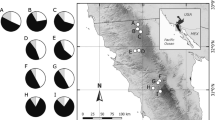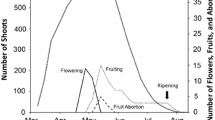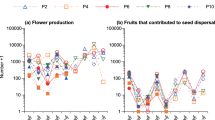Abstract
We studied the relationship between the removal rate and the spatiotemporal availability of ripe fruits of the tropical deciduous shrub Erythroxylum havanense in western Mexico. We also evaluated the effects of dispersal on seed survival during the first stages of establishment. Fast and early dispersal should be favored in E. havanense, since propagules have more time to grow and accumulate resources before the beginning of the severe dry season. In general, high rates of fruit removal imply faster and earlier dispersal. Thus, plants producing large crops should benefit from high removal rates, which will increase the probability of successful establishment by their progeny. To characterize both individual and population fruiting patterns, we made daily counts of fruits on 51 plants arranged in six clumps of different sizes. The daily number of fruits removed per plant was higher for plants with larger initial crop sizes and larger numbers of ripe fruits on a given day, but decreased as clump size increased. Additionally, we monitored postdispersal survival and germination in an experiment manipulating seed density, distance from adult plants, and seed predation. Early establishment was independent of density or distance, and vertebrate seed predation was the main agent of seed mortality. Our results indicate that the critical variable with respect to fruit removal is the number of fruits a plant produces, large plants having higher dispersal rates. Large plants are also more likely to have more seeds escaping postdispersal seed predation.
Similar content being viewed by others
References
Augspurger CK (1981) Reproductive synchrony of a tropical shrub: experimental studies on the effects of pollinators and seed predators on Hybanthus prunifolius (Violaceae). Ecology 62:775–788
Avila G (1991) Efectos maternos y paternos sobre la producción de semillas y el desempeño del arbusto heterostílico Erythroxylum havanense Jacq. (Erythroxylaceae). BSc thesis; U.N.A.M., Mexico
Bullock SH (1986) Climate of Chamela, Jalisco, and trends in the south coastal region of Mexico. Arch meteorol Geophys Bioclimatol Ser B 36:297–316
Bullock SH, Solís-Magallanes JA (1990) Phenology of canopy trees of a tropical deciduous forest in Mexico. Biotropica 22: 22–35
Clark DA, Clark DB (1984) Spacing dynamics of a tropical rain forest tree: evaluation of the Janzen-Connell model. Am Nat 124:769–788
Denslow JS (1987) Fruit-removal from aggregated and isolated bushes of the red elderberry, Sambucus pubens. Can J Bot 65: 1229–1235
Denslow JS, Moermond TC, Levey DJ (1986) Spatial components of fruit display in understory trees and shrubs. In: Estrada A, Fleming TH (eds) Frugivores and seed dispersal in the tropics. Junk, Dordrecht, pp 37–44
Domínguez CA (1990) Consecuencias ecológicas y evolutivas del patrón de floración sincrónico y masivo de Erythroxylum havanense Jacq. (Erythroxylaceae). PhD thesis, U.N.A.M., Mexico
Domínguez CA, Dirzo R (1995) Rainfall and flowering synchrony in a tropical shrub: variable selection on the flowering time of Erythroxylum havanense. Evol Ecol 9:204–216
Fleming TH (1981) Fecundity, fruiting pattern, and seed dispersal in Piper amalago (Piperaceae), a bat-dispersed tropical shrub. Oecologia 51:42–46
Garwood NC (1983) Seed germination in a seasonal tropical forest in Panama: a community study. Ecol Monogr 53:159–181
Gryj EO (1990) Dispersión de frutos del arbusto Erythroxylum havanense Jacq. en Chamela, Jalisco. BSc Thesis, U.N.A.M., Mexico
Herrera CM (1984) Adaptation to frugivory of Mediterranean avian seed dispersers. Ecology 65:609–617
Herrera CM (1986) Vertebrate-dispersed plants: why they don't behave the way they should. In: Estrada A, Fleming TH (eds) Frugivores and seed dispersal in the tropics. Junk, Dordrecht, pp 5–18
Howe HF (1977) Bird activity and seed dispersal of a tropical wet forest tree. Ecology 58:539–550
Howe HF, De Steven D (1979) Fruit production, migrant bird visitation, and seed dispersal of Guarea glabra in Panama. Oecologia 39:185–196
Howe HF, Vande Kerckhove GA (1980) Nutmeg dispersal by tropical birds. Science 210:925–927
Howe HF, Vande Kerckhove GA (1981) Removal of wild nutmeg (Virola surinamensis) crops by birds. Ecology 62:1093–1106
Howe HF, Schupp EW, Westley LC (1985) Early consequences of seed dispersal for a neotropical tree (Virola surinamensis). Ecology 66:781–791
Jordano P (1982) Migrant birds are the main dispersers of blackberries in southern Spain. Oikos 38:183–193
Lott EJ, Bullock SH, Solís-Magallanes JA (1987) Floristic diversity and structure of upland arroyo forest of coastal Jalisco. Biotropica 19:228–235
Manasse RS, Howe HF (1983) Competition for dispersal agents among tropical trees: influences of neighbors. Oecologia 59: 185–190
Moermond TC, Denslow JS, Levey DJ, Santana CE (1986) The influence of morphology on fruit choice in neotropical birds. In: Estrada A, Fleming TH (eds) Frugivores and seed dispersal in the tropics. Junk, Dordrecht, pp 137–146
Murray KG (1987) Selection for optimal fruit-crop size in birddispersed plants. Am Nat 129:18–31
Rzedowski J (1978) Vegetación de México. Limusa, México
Sargent S (1990) Neighborhood effects on fruit removal by birds: a field experiment with Viburnum dentatum (Caprifoliaceae). Ecology 74:1289–1298
Schupp EW (1988) Seed and early seedling predation in the forest understory and in treefall gaps. Oikos 51:71–78
Skutch AF (1980) Arils as food of tropical American birds. Condor 82:31–42
Stiles EW (1993) The influence of pulp lipids on fruit preference by birds. Vegetatio 107/108:227–236
Terborgh J (1986) Community aspects of frugivory in tropical forests. In: Estrada A, Fleming TH (eds) Frugivores and seed dispersal in the tropics. Junk, Dordrecht, pp 371–384
Thompson JN, Willson MJ (1979) Evolution of temperate fruit/bird interactions: phenological strategies. Evolution 33: 973–982
Van der Pijl L (1982) Principles of Dispersal in Higher Plants. Springer, Berlin Heidelberg New York
Wheelwright NT, Orians GH (1982) Seed dispersal by animals: contrasts with pollen dispersal, problems of terminology, and constraints on coevolution. Am Nat 119:402–413
Author information
Authors and Affiliations
Corresponding author
Rights and permissions
About this article
Cite this article
Gryj, E.O., Domíguez, C.A. Fruit removal and postdispersal survivorship in the tropical dry forest shrub Erythroxylum havanense: ecological and evolutionary implications. Oecologia 108, 368–374 (1996). https://doi.org/10.1007/BF00334663
Received:
Accepted:
Issue Date:
DOI: https://doi.org/10.1007/BF00334663




